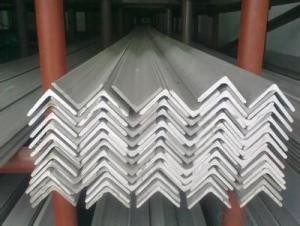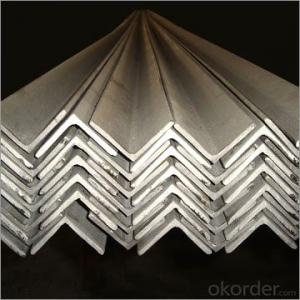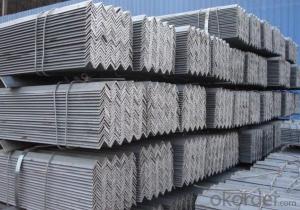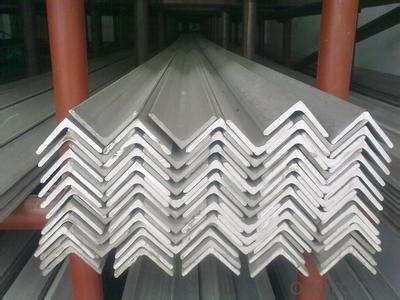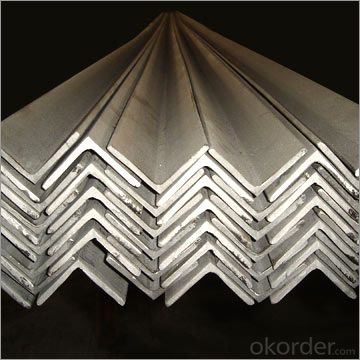ANGLE STEEL HOT ROLLED 20MM-250MM S235JR S335JR
- Loading Port:
- Tianjin
- Payment Terms:
- TT OR LC
- Min Order Qty:
- 25 m.t.
- Supply Capability:
- 200000 m.t./month
OKorder Service Pledge
OKorder Financial Service
You Might Also Like
Specification
Product Description:
OKorder is offering high quality Hot Rolled Steel I-Beams at great prices with worldwide shipping. Our supplier is a world-class manufacturer of steel, with our products utilized the world over. OKorder annually supplies products to European, North American and Asian markets. We provide quotations within 24 hours of receiving an inquiry and guarantee competitive prices.
Product Applications:
According to the needs of different structures, Angle can compose to different force support component, and also can be the connections between components. It is widely used in various building structures and engineering structures such as roof beams, bridges, transmission towers, hoisting machinery and transport machinery, ships, industrial furnaces, reaction tower, container frame and warehouse etc
Product Advantages:
OKorder's ANGLE STEEL HOT ROLLED 20MM-250MM S235JR S335JR are durable, strong, and resist corrosion.
Main Product Features:
· Premium quality
· Prompt delivery & seaworthy packing (30 days after receiving deposit)
· Corrosion resistance
· Can be recycled and reused
· Mill test certification
· Professional Service
· Competitive pricing
Product Specifications:
Manufacture: Hot rolled
Grade: Q195 – 235
Certificates: ISO, SGS, BV, CIQ
Length: 6m – 12m, as per customer request
Packaging: Export packing, nude packing, bundled
Sizes: 25mm-250mm | ||||||||||||
a*t | ||||||||||||
25*2.5-4.0 | 70*6.0-9.0 | 130*9.0-15 | ||||||||||
30*2.5-6.6 | 75*6.0-9.0 | 140*10-14 | ||||||||||
36*3.0-5.0 | 80*5.0-10 | 150*10-20 | ||||||||||
38*2.3-6.0 | 90*7.0-10 | 160*10-16 | ||||||||||
40*3.0-5.0 | 100*6.0-12 | 175*12-15 | ||||||||||
45*4.0-6.0 | 110*8.0-10 | 180*12-18 | ||||||||||
50*4.0-6.0 | 120*6.0-15 | 200*14-25 | ||||||||||
60*4.0-8.0 | 125*8.0-14 | 250*25 | ||||||||||
FAQ:
Q1: Why buy Materials & Equipment from OKorder.com?
A1: All products offered byOKorder.com are carefully selected from China's most reliable manufacturing enterprises. Through its ISO certifications, OKorder.com adheres to the highest standards and a commitment to supply chain safety and customer satisfaction.
Q2: How do we guarantee the quality of our products?
A2: We have established an advanced quality management system which conducts strict quality tests at every step, from raw materials to the final product. At the same time, we provide extensive follow-up service assurances as required.
Q3: How soon can we receive the product after purchase?
A3: Within three days of placing an order, we will begin production. The specific shipping date is dependent upon international and government factors, but is typically 7 to 10 workdays.
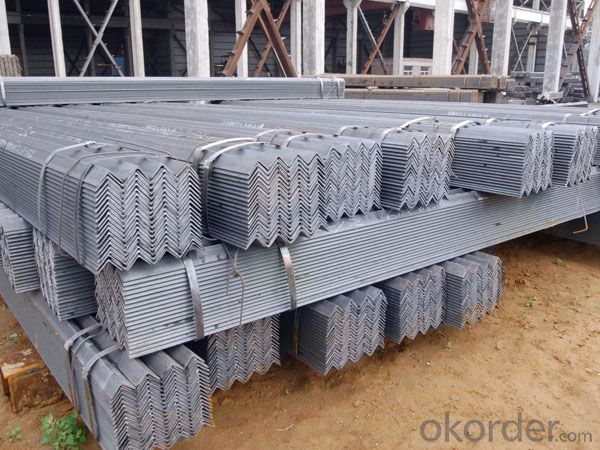
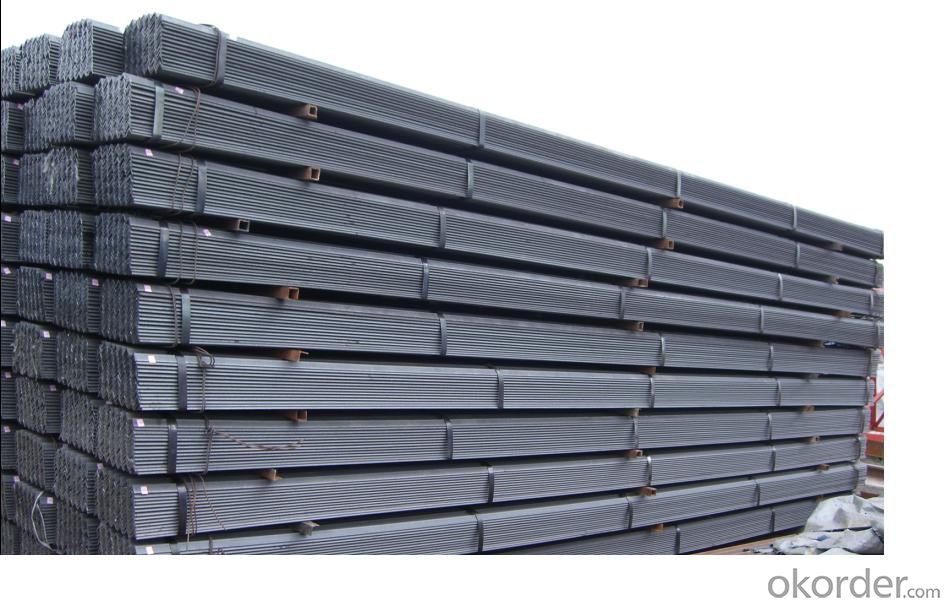
- Q: Can steel angles be used for support structures?
- Yes, steel angles can be used for support structures. Steel angles are commonly used in construction and engineering industries for various purposes, including providing support and stability to structures. The L-shape of steel angles allows them to be easily bolted or welded together, making them ideal for creating strong and durable support structures. They are often used in applications such as building frames, roof trusses, bridges, and industrial platforms. Additionally, steel angles offer excellent load-bearing capacity and resistance to bending and twisting forces, making them a reliable choice for support structures.
- Q: What is the maximum span for a steel angle?
- The maximum span for a steel angle depends on various factors such as the size, shape, and thickness of the angle, as well as the load it is expected to bear. Generally, larger and thicker steel angles have a greater maximum span. However, it is essential to consult structural engineering standards and codes, as well as professional engineers, to determine the specific maximum span for a particular steel angle in a given application. These experts will consider factors such as the material's yield strength, deflection limits, and safety factors to provide accurate guidelines for the maximum span.
- Q: What are the different methods for painting steel angles?
- There are various approaches to painting steel angles, depending on the desired outcome and project conditions. Some commonly used methods include: 1. Applying with a brush: This traditional method involves using a paintbrush to directly apply paint onto the steel angle's surface. It offers greater control and precision, especially for smaller or intricate areas. 2. Utilizing spray application: Spray painting is favored for large-scale or industrial projects. It entails using a paint sprayer to evenly distribute paint onto the steel angle. This method is quicker and more efficient than brush application, resulting in a smooth, uniform finish. 3. Employing powder coating: This method involves applying a dry powder to the steel angle and then curing it under heat. The result is a durable and visually appealing finish. Powder coating is known for its resistance to chipping, scratching, and fading, making it ideal for outdoor applications or high-traffic areas. 4. Using electrostatic painting: Electrostatic painting employs an electric charge to attract paint particles to the steel angle. This technique ensures even coverage, reduces overspray, and yields a smooth and long-lasting finish. It is commonly used for large or complex surfaces due to its superior adhesion and coverage. 5. Opting for galvanizing: Galvanizing is a unique method used to protect steel angles from corrosion. It involves coating the steel angle with a layer of zinc through a hot-dip or electroplating process. Galvanized steel angles are highly durable and resistant to rust, making them suitable for outdoor or high-moisture environments. While galvanizing does not provide a specific color or aesthetic finish, the zinc coating can be painted over if desired. When selecting a painting method for steel angles, it is crucial to consider factors such as the desired appearance, durability, environmental conditions, and project specifications. Seeking guidance from a professional or adhering to the manufacturer's recommendations can help ensure the most suitable method is chosen for each unique project.
- Q: What are the typical uses for steel angles?
- Various industries and construction projects make extensive use of steel angles. Structural framing is one of the most common applications, where steel angles provide added strength and support to buildings and structures. They play a crucial role in creating bracing, reinforcing, and framing elements like beams, columns, and trusses. Steel angles also find significant use in manufacturing and fabrication. They are employed in the production of machinery, equipment, and vehicles due to their ability to withstand heavy loads without bending or warping. They serve as frames, supports, or brackets for various industrial equipment and machinery. Furthermore, steel angles are widely utilized in furniture manufacturing, particularly in metalwork and carpentry. They function as corner brackets or connectors, offering stability and strength to furniture pieces like tables, chairs, and shelves. Additionally, steel angles are commonly integrated into storage racks and shelving systems to ensure durability and stability when holding heavy loads. In the transportation industry, steel angles are frequently incorporated into the manufacturing of trailers, truck beds, and vehicle frames. Their high strength and resistance to impact and vibrations make them well-suited for these applications, ensuring the longevity and structural integrity of the vehicles. Overall, steel angles have a broad range of uses across various industries and projects. Their versatility, strength, and durability make them a sought-after choice for structural support, manufacturing, furniture construction, and numerous other endeavors that demand robustness and stability.
- Q: What is the minimum thickness for a steel angle bracket?
- The minimum thickness for a steel angle bracket often depends on the specific application and the load it is intended to support. However, in general, a minimum thickness of 1/8 inch (3.175 mm) is commonly used for angle brackets. This thickness provides sufficient strength and rigidity to withstand typical loads and forces. It is important to note that for heavier loads or specialized applications, thicker steel brackets may be required to ensure adequate structural integrity and safety. It is recommended to consult with a structural engineer or follow relevant industry standards and guidelines for determining the appropriate minimum thickness for a steel angle bracket in a specific application.
- Q: What are the load-bearing capacities of steel angles?
- The load-bearing capacities of steel angles vary depending on various factors such as the size and thickness of the angle, the type of steel used, and the specific application. In general, steel angles are designed to provide structural support and can handle significant loads. The load-bearing capacity of a steel angle is determined by its bending strength and its ability to resist compression and tension forces. These factors are influenced by the material properties of the steel, including its yield strength, tensile strength, and ductility. Steel angles are commonly used in construction and engineering projects for applications such as supporting beams, frames, and structures. The load-bearing capacity of a steel angle is often specified by engineers or designers based on the specific requirements of the project and the anticipated loads. To determine the load-bearing capacity of a steel angle, calculations and structural analysis are typically performed using engineering principles and standards. These calculations consider factors such as the angle's dimensions, support conditions, and the expected loads. It is important to consult relevant engineering codes and standards, such as those provided by organizations like the American Institute of Steel Construction (AISC) or British Standards Institution (BSI), to ensure that the load-bearing capacity of a steel angle meets the necessary requirements for a given application. In summary, the load-bearing capacities of steel angles can vary depending on several factors. Consulting with a structural engineer or referring to appropriate engineering standards is crucial to accurately determine the load-bearing capacity of a specific steel angle in a given application.
- Q: How do steel angles contribute to the overall strength of a structure?
- Steel angles contribute to the overall strength of a structure in several ways. First and foremost, they provide structural stability by distributing the load and forces evenly throughout the structure. The L-shape of steel angles allows them to resist bending and twisting, making them ideal for providing support and preventing deformation. Steel angles are often used as bracing elements in construction due to their high strength-to-weight ratio. By adding diagonal steel angles to a structure, it becomes more resistant to lateral forces such as wind or seismic loads. These angles help to transfer the applied forces to the foundation, reducing the risk of structural failure. Another way steel angles contribute to strength is by providing additional reinforcement. They can be strategically placed at critical points of a structure, such as corners or joints, to enhance its overall rigidity and durability. Steel angles can also be used as framing members, supporting beams, or columns, further enhancing the load-bearing capacity of the structure. Moreover, steel angles are resistant to corrosion and have a long lifespan, making them a reliable choice for structural applications. They can withstand harsh environmental conditions, ensuring the structural integrity of the building over time. Overall, steel angles play a crucial role in enhancing the strength and stability of a structure. Their ability to distribute loads, resist bending and twisting, provide reinforcement, and withstand environmental factors make them an essential component in modern construction.
- Q: What are the common shapes and dimensions of steel angles?
- There is a wide range of options for steel angles in terms of shape and dimensions to accommodate various uses. The most common shapes are L-shaped or right angles, with legs that can be equal or unequal. These angles are typically created by bending a piece of steel into the desired shape. In terms of size, steel angles can vary depending on their intended purpose. The length of the legs, which are the two sides of the angle, can range from a few inches to several feet. The thickness or gauge of the steel used to make angles can also vary, with thinner gauges being lighter and thicker gauges providing more strength. The most commonly used dimensions for steel angles are as follows: - Equal Leg Angles: These angles have legs of equal length, forming a 90-degree angle. Common sizes for equal leg angles range from 1/2 inch to 6 inches in leg length, with thicknesses ranging from 1/8 inch to 1/2 inch. - Unequal Leg Angles: These angles have legs of different lengths, forming a 90-degree angle. The longer leg is usually referred to as the "vertical leg" and the shorter leg as the "horizontal leg." Common sizes for unequal leg angles range from 1 inch to 6 inches in vertical leg length, with thicknesses ranging from 1/8 inch to 1/2 inch. It's important to note that these dimensions serve as general guidelines, and custom-made steel angles can be produced to meet specific requirements. Additionally, steel angles can be hot-rolled or cold-formed, which affects their structural properties and manufacturing processes. Therefore, it's crucial to consult the specific standards and regulations applicable to your project or industry when selecting steel angles.
- Q: Can steel angles be used in industrial or heavy-duty applications?
- Absolutely, steel angles are a perfect fit for industrial or heavy-duty uses. Renowned for their robustness, endurance, and flexibility, steel angles are highly versatile and find application across a wide range of industries. They play a vital role in providing structural reinforcement, support, and stability to heavy-duty machinery, equipment, and infrastructure projects. Construction, manufacturing, engineering, transportation, and various other industries commonly employ steel angles. Their usage spans frames, supports, bracings, platforms, beams, and trusses, where strength and load-bearing capacity are paramount. Moreover, steel angles can withstand extreme temperatures, harsh weather conditions, and heavy loads, making them ideal for demanding industrial environments. In summary, steel angles are a dependable and efficient choice for industrial or heavy-duty applications, thanks to their strength, durability, and adaptability.
- Q: How are steel angles protected against abrasion?
- Steel angles are commonly used in construction and industrial applications, where they are subject to various forms of abrasion. To protect steel angles against abrasion, several methods are employed. One common method is the application of protective coatings. These coatings can be in the form of paints, epoxy coatings, or other specialized coatings designed for abrasion resistance. The coatings act as a barrier between the steel surface and the abrasive elements, preventing direct contact and reducing the wear and tear caused by friction. Another method is the use of rubber or plastic linings. These linings are typically applied to the surfaces of the steel angles that are most prone to abrasion. The rubber or plastic material absorbs the impact of abrasive forces, cushioning the steel and reducing the wear rate. Additionally, these linings provide an extra layer of protection against corrosion and chemical attacks. In some cases, steel angles may undergo a process called hardening or heat treatment. This involves subjecting the steel to high temperatures and then rapidly cooling it. This process alters the microstructure of the steel, making it harder and more resistant to abrasion. Heat-treated steel angles are commonly used in high-wear environments such as mining and material handling industries. Furthermore, engineers may opt to design steel angles with specific profiles or shapes that offer better resistance to abrasion. These profiles can include rounded edges, chamfers, or other features that minimize direct contact with abrasive materials. Overall, the protection against abrasion for steel angles involves a combination of protective coatings, linings, heat treatment, and thoughtful design. By implementing these measures, the lifespan and performance of steel angles can be significantly prolonged, reducing maintenance costs and ensuring their durability in abrasive environments.
Send your message to us
ANGLE STEEL HOT ROLLED 20MM-250MM S235JR S335JR
- Loading Port:
- Tianjin
- Payment Terms:
- TT OR LC
- Min Order Qty:
- 25 m.t.
- Supply Capability:
- 200000 m.t./month
OKorder Service Pledge
OKorder Financial Service
Similar products
Hot products
Hot Searches
Related keywords
